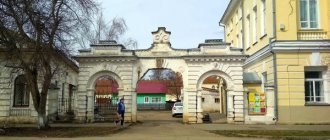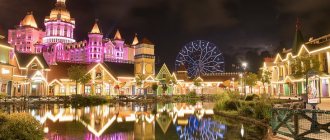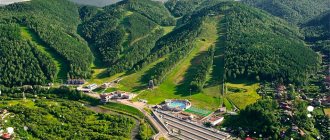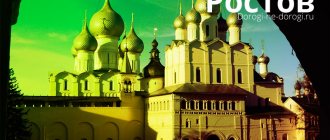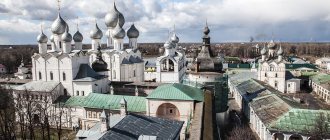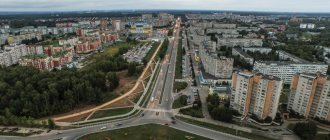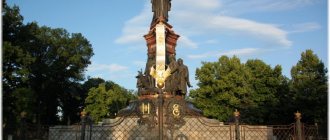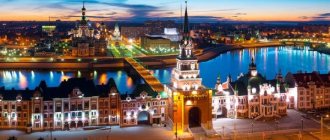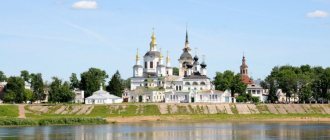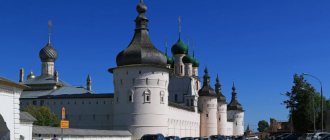| Sights of Veliky Novgorod in winter Museums Festivals and holidays Theaters, concerts Active recreation Stories, routes and tips from tourists with photos Where to stay in Veliky Novgorod Excursions from Veliky Novgorod in winter |
Veliky Novgorod is a popular tourist destination in winter. During this period, one of the oldest cities in Russia looks especially authentic: the Kremlin rampart under the snow, fairgrounds with folk entertainment and warming drinks, frost-covered domes of churches. There are much fewer tourists in the winter city, which means you can completely immerse yourself in the atmosphere of Medieval Rus'.
The weather in Veliky Novgorod in winter is quite mild. Usually, in the winter months the air temperature does not drop below -10-15 degrees. Permanent snow cover is established by the second half of November and early December. January is considered the best month for traveling in winter - during the New Year holidays the city sparkles with festive illumination, fairs are held and folk festivals are organized.
Novgorod Kremlin Photo: © Tatyana Tolstousova
Sights of Veliky Novgorod in winter
Getting to know the city, founded in 859, is worth starting with its architectural monuments. The city escaped destruction by the Mongols - local architecture clearly demonstrates the masterpieces of ancient Russian architecture like nowhere else. The historical sites of Veliky Novgorod and its surroundings are included in the UNESCO World Heritage List. Archaeological excavations are still underway in the city - the so-called “cultural layer” lies at a depth of up to 8 meters.
Novgorod Kremlin
The Novgorod Kremlin or Detinets was first mentioned in chronicles in 1044. This is one of the most ancient fortresses of Ancient Rus', which has been perfectly preserved to this day. The Kremlin was built on a high bank (10 meters) of the Volkhov River. The borders of Novgorod Detinets changed several times - until the 15th century. The first Kremlin, under Yaroslav the Wise, was made of wood. Now a ring of walls with 9 towers limits a space of 12 hectares. The length of the Kremlin walls is 1.5 km. The height of the walls varies from 8 to 15 meters. Through several Kremlin towers there is a tourist route “The Battle of the Kremlin”, but in winter it is closed to the public. Group excursions are organized from time to time.
The main attraction of Detinets is the St. Sophia Cathedral , built in the 11th century. The cathedral does not look solemn, but rather restrained in a northern way. This architectural style is characteristic only of churches of that century - the St. Sophia Cathedrals in Kyiv and Belarusian Polotsk look similar. Also notable is the Sofia Belfry , built in the 15th century. The separate wall-shaped belfry inside has an exhibition dedicated to bells and an observation deck. But in winter, only external inspection is possible.
More details: Novgorod Kremlin
Novgorod Kremlin Photo: © Tatyana Tolstousova
Yaroslav's yard
On the opposite bank of the Volkhov River (across the bridge from Detinets) there is another important historical place of Veliky Novgorod - Yaroslav's Dvorishche or Torg. According to legend, the palace of Yaroslav the Wise was located here - hence the first name. The historical quarter received its second name from the shopping area that was located here later. Now only the surviving arcade of Gostiny Dvor .
Yaroslav's Dvorishche is notable for its churches of past centuries - each with its own history and characteristics. Some of them now house museum exhibitions. The main temple of this area is the St. Nicholas Cathedral . The temple was erected in the first half of the 11th century. This is a large temple, but restrained in decoration. From the first years of its foundation, fragments of frescoes have been preserved - they can be seen in the lower part of the temple, in the under-church.
Temple of the Myrrh-Bearing Women , erected at the beginning of the 16th century, is notable for its neat rounded shape. Now an ethnographic exhibition is organized inside. The Church of Paraskeva Pyatnitsa on Torg , founded in 1207, stands out for its facade - this is the original masonry of the 13th–16th centuries. Other churches of the Yaroslav's courtyard are also interesting for inspection: Church of John the Baptist on Opoki , Church of St. George on Torg , Church of the Assumption of the Blessed Virgin Mary on Torg , Church of Procopius .
Details: Yaroslav's yard
Temple of the Myrrh-Bearing Women on Yaroslav's Courtyard Photo: © Tatyana Tolstousova
Museum of Wooden Architecture "Vitoslavlitsy"
The open-air museum, dedicated to wooden buildings from the settlements of the Novgorod region, looks especially charming in winter. Wooden huts under the snow do not look like museum exhibits - you get the feeling that you have arrived in an ancient Russian village. The surroundings are complemented by museum curators - they greet visitors in ancient clothes, colorful scarves and kokoshniks. The main exhibits of the Vitoslavlitsy Museum are wooden churches built in the 16th–18th centuries. Also interesting are the huts, inside of which the life of Novgorod peasants is recreated. But it is worth keeping in mind that during the winter months some exhibitions inside peasant huts are closed to viewing. Only external inspection of buildings is possible.
The museum is surrounded by a picturesque forest, which in winter creates the feeling of a fairy tale. It is especially beautiful in the area on a frosty sunny day. But you need to dress warmly - there is no heating in the huts, and there is no cafe on the territory of the museum either.
More details: Museum of Wooden Architecture "Vitoslavlitsy"
Museum of Wooden Architecture “Vitoslavlitsy” Photo: © Tatyana Tolstousova
St. George's Monastery
The main monastery of the city is considered to be Svyato-Yuryev , located near the Vitoslavlitsy museum. The monastery was founded by Yaroslav the Wise in 1030. In the 15th century it was one of the richest monasteries in Rus'. In the St. George's Cathedral at the Yuriev Monastery there is a tomb of Russian princes, including the brother of Alexander Nevsky. In the interior decoration you can see frescoes from the 12th century. Also of interest are Spassky Cathedral , the 52-meter bell tower and the Holy Cross Cathedral .
Details: St. George's Monastery
St. George's Monastery Photo: © alla38
If you have time, you can also go to other monasteries - in the vicinity of Veliky Novgorod there are several holy monasteries for women and men.
Detailed materials on what to see in Veliky Novgorod
For 1 day For 2 days In summer
Historical buildings and monuments
The city resembles an open-air museum; each street has its own history. Children find it interesting to travel through time, especially when adults are able to captivate them with a story.
Novgorod child
The fortress located on the left bank of the river is included in the UNESCO list of architectural monuments and has federal significance as an example of architecture. The wooden structure was founded in the 10th century, and the Kremlin gradually grew around it. The complex is considered a part of history.
Clock ringing
The clock tower is located in the northwestern side of the Kremlin. Similar buildings no longer survive. It is the tallest of the buildings in the complex and is one of the sloping buildings, tilting slightly to the side. It was damaged during the war, the pommel was restored, and the ancient mechanism was restored, marking every 30 minutes by striking a bell.
Kokuy Tower in the Kremlin
The solid quadrangular structure reaches a height of 38.5 meters and is the highest building of the complex. The wide base gradually becomes thinner towards the upper tiers, turning into a polyhedron. It had a defensive function; at the last levels there was an observation post. Now there is an observation deck, the entrance to which runs through one of the through galleries.
Yaroslav's yard
The complex is located on the right bank opposite Detinets, closer to the southern part. It has historical significance, since once upon a time a council gathered at that place, there was brisk trade with overseas merchants, and the berths received merchant ships. In warehouses, accounting, labeling, and preparation of goods for shipment were carried out. Later, Gostiny Dvor appeared on the territory.
Gate tower of Gostiny Dvor
Wooden city buildings often burned down in fires, and fires in shopping arcades were especially devastating. By decree of Peter I, their replacement with stone buildings began. By the 18th century, almost all buildings were made of brick. Arches marked the entrance to the Courtyard. A two-story building with a mezzanine was erected in the center.
It was intended to house security guards, trading offices, and warehouses. Later, a museum of religious objects, antiquities, and artistic forging settled in it.
Alekseevskaya Tower
The city's southern defense line has almost disappeared. Only one tower remained from it, which is often called the White Tower. The round base is 17 meters in diameter, the lower tiers are made of large cobblestones and lined with brick. Thick walls and loophole windows demonstrate power and inaccessibility. Most recently, the tower opened to visitors and operates as a museum of ancient Russian weapons.
Belfry
The ringing of bells spreads everywhere, the ancient bell tower still regularly carries out its service, towering over the streets and squares since the 13th century. It was rebuilt several times, restored after the fall, restored without changing its original outline and only becoming taller. The Sofia belfry is considered the largest and oldest bell structure.
Faceted or Sovereign Chamber
Of the entire complex of the Vladychny Court, only this one has survived. The architectural monument belongs to the brick Gothic style of the 15th century and is included in the UNESCO lists as one of the oldest civil buildings. It is very interesting to look at the surviving frescoes, in which the interweaving of Byzantine and Russian painting styles is clearly visible. On the third floor there is a bright hall where trials, divine services, and the selection of priests took place.
Now within its walls there is an exhibition of objects of decorative and applied art, including samples of gold and silver jewelry by ancient masters, temple utensils, and artifacts.
Monument "Millennium of Russia"
The date of formation of the Russian state is considered to be the proclamation of Rurik as Prince of Rus'. The opening of the monument took place in 1862. It is located in the center. The authors of the monument were M. Mikeshin, I. Schroeder, W. Hartmann. It is made in the form of a bell, on which 128 figures are located in 3 tiers:
- the upper tier symbolizes the church, country and autocracy;
- middle - 6 main historical eras;
- on the lower one are carved high reliefs of 109 famous people, including educators, statesmen, military leaders, heroes, artists and writers.
Victory Monument
The monument was opened in 1974, on the 30th anniversary of the liberation of Novgorod from the fascist invaders, and is classified as a cultural heritage site. The central figure of the composition was an equestrian sculpture, behind it a high tower topped with a boat with military attributes. Bas-reliefs on the walls depict the main stages of the war and the battles for Novgorod.
Museums
Daylight hours in winter in Veliky Novgorod are 6–8.5 hours depending on the month. The short daylight hours and cold weather are not conducive to long walks. Therefore, tourist routes around winter Veliky Novgorod must include museums. If your plans include not only walks with external sightseeing, but also visits to museums, churches and excursions around Veliky Novgorod, then it is worth purchasing the “Guest Card of Novgorod Rus'”. A single tourist ticket gives the right to visit 50 museums and other tourist sites in the Novgorod region. What to see from museums in Veliky Novgorod in winter? The list of the most interesting options is below.
Museum of Wooden Architecture “Vitoslavlitsy” Photo: © Tatyana Tolstousova
Novgorod Historical and Architectural Museum
The museum is located on the territory of the Kremlin, in the building of the Chambers of Representatives . The largest collection of archaeological ancient Russian artifacts in Russia is exhibited here. Now there are about 200 thousand exhibits, and the collection continues to grow - excavations are still underway in the Novgorod Kremlin. The most valuable exhibit is considered to be the first Russian book - the Novgorod Psalter. Also interesting are ancient birch bark letters (there are 805 of them in the museum) and one of the oldest icons - Saints Peter and Paul.
Center for Musical Antiquities of V. I. Povetkin
of the Center for Musical Antiquities will help you immerse yourself in the culture of our ancestors . Old Russian musical instruments from the 10th to 15th centuries are collected here. Guests can listen to the sound of some instruments and ancient folk songs from different regions of Russia: Pskov, Arkhangelsk, Novgorod and other regions. If you visit Veliky Novgorod during the holidays, you can catch a concert of the local choir in the center of musical antiquities.
More details: V. I. Povetkin Center for Musical Antiquities
Center for Musical Antiquities V.I. Povetkina Photo: © Vladimir Shalaev
Vladyka Chamber
The brick building in the Western European Gothic style is located on the territory of Detinets. Previously, ceremonial events were held on the top floor, and the cellar was located below. The place has important historical significance - the name of the state - “Russia” was first pronounced here when Novgorod was annexed to Moscow. Nowadays, within the walls of the Vladychnaya (also called the Faceted) Chamber, a collection of items by Russian jewelers dating back to the 10th century is exhibited.
Details: Vladyka Chamber
Art Museum
The historic building on Sophia Square (formerly the Assembly of the Nobility) houses collections of paintings, sculptures, weapons and exquisitely carved bone objects. The most noteworthy is the exhibition with paintings by Russian painters. The museum's collection includes works by Repin, Aivazovsky, Roerich, Vasnetsov and other artists of the 19th and early 20th centuries.
More details: Veliky Novgorod Museum of Fine Arts
Which museums in Veliky Novgorod are closed to visitors in winter? Basically, these are churches that are not heated in winter and are not active. This is the Church of the Annunciation in Myachino, the Sofia Belfry and some other objects in the region.
Detailed material: Museums of Veliky Novgorod
Novgorod Kremlin Photo: © Tatyana Tolstousova
Where else to go in winter
Another visiting card of Nizhny Novgorod is the Nizhny Novgorod Fair
(Sovnarkomovskaya st., 13). This is one of the few attractions in the lower part of the city. Some of the buildings were built during the time of Peter I. You will recognize them by the luxurious decoration of their facades. Inside there are retail premises and the Quarks science museum.
Kashirin's House museum
(Pochtovyy congress st., 21).
Maxim Gorky spent his childhood here, whose name the city bore for a long time. And in the GAZ History Museum
(Lenin Ave., 95) you can look at a collection of rare cars. They are all on the go and taking part in filming and celebrations. For example, cars that appeared in the films “The Diamond Arm”, “Beware of the Car”, “Three Plus Two”, etc. are exhibited here.
In good sunny weather you can go to Switzerland Park
(Gagarin Ave., 35). It’s nice to walk among the snow-covered trees here or admire the Oka River from the slopes.
Photo: @peac_hh
Festivals and holidays
Several dozen festivals take place on Novgorod land throughout the year. Most of them are dedicated to summer Slavic and Russian holidays. But even in the winter months there are several interesting festivals that are worth visiting.
December in Veliky Novgorod begins with the family holiday “Winter has come! Brought the codfish!” . The holiday takes place on the territory of the Kremlin. Instead of the usual Father Frost, visitors are greeted by the more severe pagan Father Treskun. The program includes ancient Russian fun and games, performances by folk groups.
During the New Year holidays, the Fairytale New Year . Adults and young visitors can get acquainted with the characters of Russian fairy tales and epics. The entertainment program includes quests with the participation of Baba Yaga and Kikimora, master classes on ancient crafts, competitions and games. During the festival, there is a fair on the territory of Vitoslavlits, where you can buy handmade souvenirs from Novgorod craftsmen.
Souvenir rows at the winter fair in Veliky Novgorod Photo: © Andrey Panin
At the end of December, the main Christmas tree of Veliky Novgorod is installed on the main square of the city, Sofia Square. Usually, the first lighting of the lights on the Christmas tree takes place in a solemn atmosphere. On New Year's Eve, mass festivities, performances by creative groups and fireworks are organized on the square.
Maslenitsa festivities take place at several venues, including on the territory of the Novgorod Kremlin and in the Vitoslavlitsy Museum. festival “Demyansk Bridgehead” is held in the city of Demyansk (120 km from Veliky Novgorod) . Reenactments of the battles with the fascist invaders that took place on this land in 1943 are organized for festival guests.
The main Christmas tree of the city on Sophia Square Photo: © Vladislav Korenkov
Theaters, concerts
During the winter period, it is easy to set aside time not only to get acquainted with the architecture of the city, but also to immerse yourself in its cultural life. Fans of performances should visit the Dostoevsky Drama Theater . One of the oldest theaters in Russia mainly hosts productions of domestic and foreign classics: “Crime and Punishment”, “Fathers and Sons”, “The Queen of Spades” and others.
With children it is worth visiting the Roger puppet theater , as well as the Maly children's and youth theater . The Roger Puppet Theater puts on performances for young children - these are educational and funny stories, interactive performances with audience participation. The Maly Theater not only stages dramatic works, but also experiments with performance art and modern dance.
In detail: Theaters of Veliky Novgorod Holidays in Veliky Novgorod with children
Novgorod Kremlin in the evening Photo: © Andrey Panin
Leisure
In Veliky Novgorod, almost every district has ice skating rinks - there are both indoor and outdoor areas. The skating rink on the territory of the Kremlin Park is of tourist interest. It is open daily until 10 pm. There are skate rentals for children and adults, as well as the opportunity to visit the skating rink with your own skates. Tubing rides are organized on the Kremlin shaft - the slides are not equipped; usually locals ride here with their “cheesecakes”.
For more active winter activities, you should go outside the city. In the Novgorod region there are several large winter recreation centers with entertainment for the whole family. If you have a free day, it's worth going to one of these resorts:
- Ski resort "Mstinskie Gorki" . The resort is located near Malaya Vishera, 130 km from Veliky Novgorod. Tourists can enjoy 4 trails of varying difficulty levels, designated areas for snow tubing, a sauna, an outdoor swimming pool, guest houses, barbecue rentals and other services.
- Eco-resort "Lyubogorye" . The distance from Veliky Novgorod is 180 km. In winter, the resort has 7 trails for skiers and snowboarders. There is a tubing slope and a forest trail for cross-country skiing. You can visit the bathhouse or rent a gazebo. Nearby is the open-air museum “Slavic Village of the 10th Century”.
Panoramic view of the Lyubogorye resort
Details: Ski resorts of the Novgorod region
Stories, routes and tips from tourists with photos
You can find out what to see in Veliky Novgorod in winter in traveler reports. By looking at reviews for a specific month, you can navigate the weather and find out which attractions are really worth visiting in winter. In the reviews of tourists you will find useful information on organizing leisure time in the city, ticket prices and route planning.
- “Mr. Veliky Novgorod. Old Ladoga" - a photo album about a visit to Novgorod in December from Vladislav Korenkov.
- “Find Onfim” - a review of a holiday in Veliky Novgorod for the New Year from Ivan Yakunin.
- “Vitoslavlitsy” or Favorite “pieces of wood” - a report on a visit to the museum in winter from Tatyana Tolstousova.
- “Winter Veliky Novgorod” - photo album from Andrey Panin.
All tourist reviews about trips to Veliky Novgorod
Urban transport
Veliky Novgorod is a major transport hub. Federal and regional highways pass through it. There is a bypass road that reduces the flow of cars inside the city. In addition to the increased number of personal cars, public transport is also developed in Novgorod: trolleybuses, minibuses and buses operate.
Novgorod is also an important railway junction.
Where to stay in Veliky Novgorod
Housing in Veliky Novgorod is compactly located both on the Sofia side with the Kremlin, and on the Torgovaya side - on both sides of the Volkhov River. It is difficult for a tourist to make a mistake when choosing a place to stay and where to go. Most offerings are within reasonable walking distance and only a few are a little further away.
Within the boundaries of the Kremlin, so as not to walk far, there is a wide selection of apartments and hotels - from 0 to 4 stars, including two chains Amaks and Park Inn. In your search you can find classic options like Volkhov or Intourist, nice boutique hotels like Truvor, or former mansions that have retained noble features like Bianchi.
- Veliky Novgorod Hotels
- Hostels for Budget Travelers
- Flats and apartments
Before booking your stay on Booking.com, take a look at the page: Cashback promotion for Tourist. RU
Museum of Wooden Architecture “Vitoslavlitsy” Photo: © Tatyana Tolstousova
Excursions from Veliky Novgorod in winter
In winter it is especially pleasant to travel around the Novgorod region and neighboring regions. Sparsely populated towns in winter look like ancient times, and the nature of the region is fabulous and enchanting. For 1-2 days from Veliky Novgorod you can travel to other cities and villages in the region. Worth a visit:
- Staraya Russa . The charm of a provincial town is especially felt in winter, when travelers see wooden huts under the snow with smoke from the stove and ancient churches. In the city, you should definitely visit the Dostoevsky House Museum , in which he wrote some of the cult novels: “Demons” and “The Brothers Karamazov”.
- Valdai . The city, located on the shores of Lake Valdai, is attractive for winter activities in the surrounding area. In the city itself it is worth visiting the bell museum and the county town museum .
- Lyakova village . The Old Believer settlement carefully preserves its traditions. Visitors to the settlement are greeted by a “hostess” who introduces them to the history and traditions of the Old Believers. Guests can take part in round dances and other entertainment, taste cabbage soup from the oven and homemade mead.
You can continue your acquaintance with the heritage of Ancient Rus' in the neighboring Pskov region. The most popular route through the region includes visits to Pskov and Izborsk. In both cities, ancient fortresses and other monuments of the Russian Middle Ages have been preserved.
Pskov Kremlin Photo: © Olga407
How to get to the city
The closest airport to Veliky Novgorod is Pulkovo Airport in St. Petersburg. You can get here from European, Russian, Asian cities, and then get to Novgorod. This can be done by taxi or car.
Getting to the city is easy by bus, as there is a bus station that accepts many intercity flights. Therefore, from St. Petersburg, Staraya Russa, Moscow, Petrozavodsk, Pskov, Tver, Chudovo, Riga and some other settlements you can take a bus to Veliky Novgorod.
Regular trains depart from St. Petersburg, namely from the Moskovsky Station, to the city on the Volkhov River. You can also get there from the Leningradsky railway station in Moscow using the same type of transport. Using your own car, a trip to the ancient city will be as comfortable as possible.

